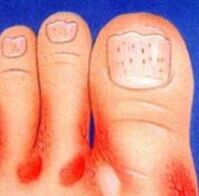According to the statistics, every tenth resident of our planet suffers from the leg fungus or, as it is also called epidermophytosis. Most of the time, men suffer from this disease, which is not due to the characteristics of physiology and the fact that male representatives are more frequent and longer than women, they wear closed shoes.
Leg fungus: causes and risk factors
The disease can be caused by one of the following reasons:

- insufficient body hygiene in general and particular foot;
- Uncomfortable and very close shoes;
- Excessive feet perspiration;
- violations in the work of the human immune system;
- Smooth feet and other types of feet deformation;
- Use of public pools and baths;
- insufficient hygiene and showers;
- Overweight;
- Problems with blood circulation in the legs.
General Symptoms of Fungus
The fungus on the legs can manifest in different ways:
- Skin inflammation on heels and pillows of the feet;
- itching of varying gravity;
- cracks;
- peeling.
A precise determination of the type of fungus that impressed the feet will help choose the correct treatment of this disease.
Fungus on the legs and their types
In medicine, it is usual to secrete 3 main types of fungi: membrane, such as moccasin, vesicular. And each of them is inherent in the general and characteristic symptoms.
Membrane fungus signs:
- location in the 4th and 5th fingers area;
- Characteristic of most types of fungi - scales;
- Itch.
The fungus in the legs of the type of mocassage differs from others:
- thickening of the sole of the feet;
- deeper cracks;
- painful sensation;
- Damage to nails, which, like the skin of the feet, are thickened, while gaining excessive fragility, which may even lead to the loss of the nail plate.

The vesicular fungus is characterized by: fluid -filled blisters and location at the bottom of the foot.
Foot Fungus: Diagnosis
The diagnosis of "foot fungus" is made by a dermatologist based on the patient's examination. More detailed studies: shaving, skin biopsy, cultivation - will help the doctor accurately determine the type of fungus that impressed the patient. In addition, the doctor conducts a survey of patients to manifest this disease in the past. The latter is especially important, as the recurring manifestations of the fungus often for a certain period of time signal the transition from the disease in a more serious way, which is more difficult to treat.
How to treat a fungus on your feet?
Foot fungus therapy does not require stationary observation and is performed on an outpatient patient. In most cases, the patient receives external antifungal medications prescribed. It is worth noting that often people suffering from the fungus of the foot do not turn to a specialist, merely taking drugs sold in a pharmacy without a prescription. This scenario often leads to a favorable result of the disease. However, it should be remembered that prolonged therapy of the disease, accompanied by a deterioration in the condition of the legs, indicates an advanced stage of the disease. The best way to get out of this situation will be to visit an expert who will help choose the ideal remedy for the fungus.



























